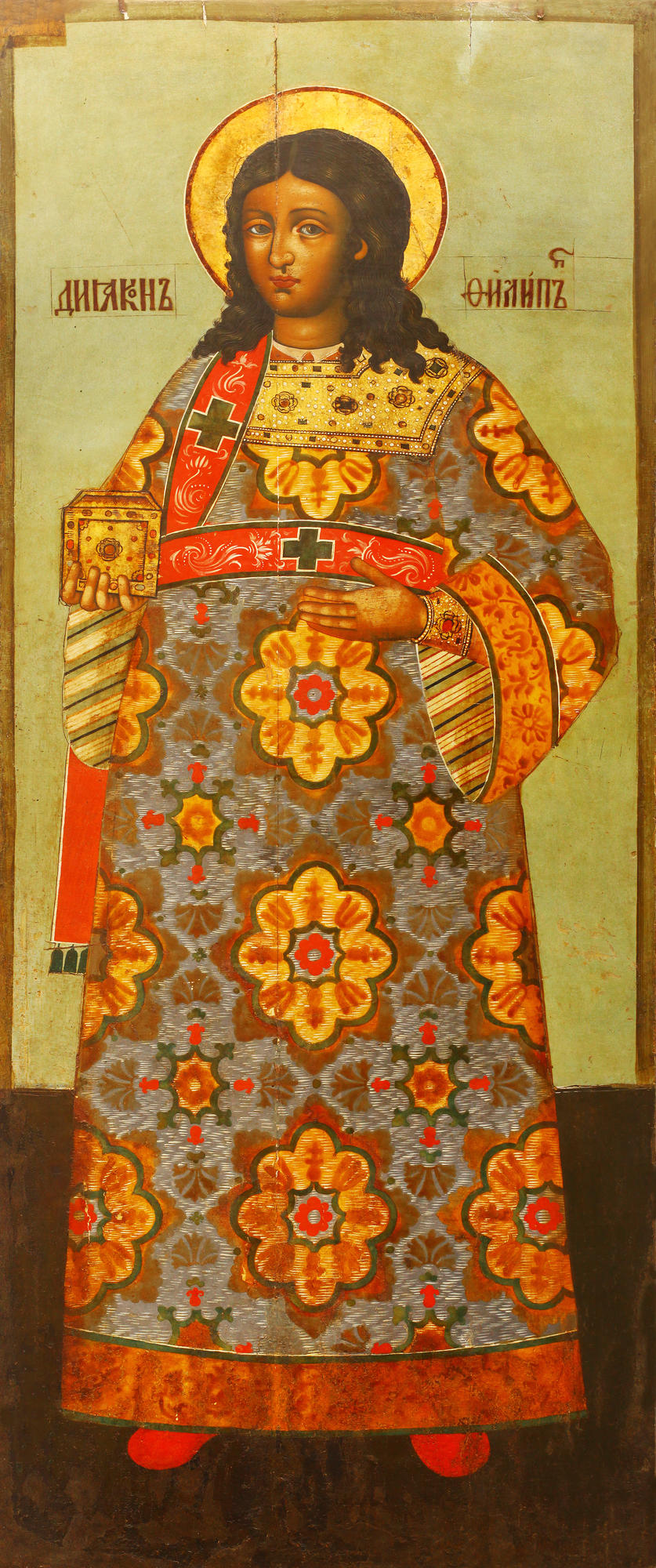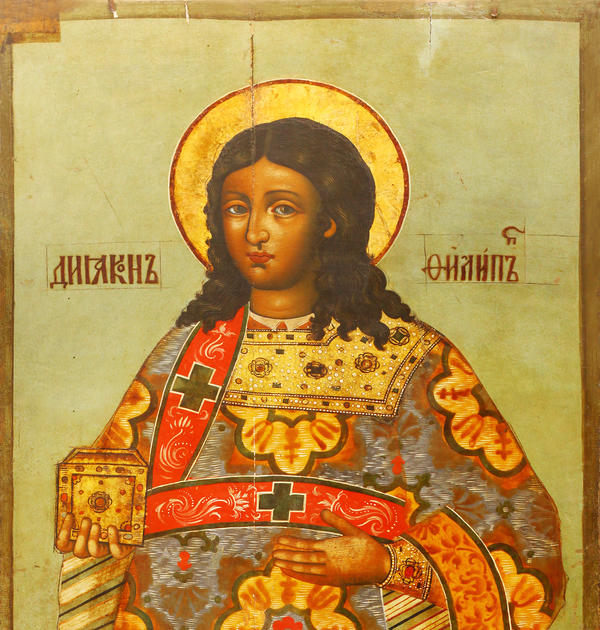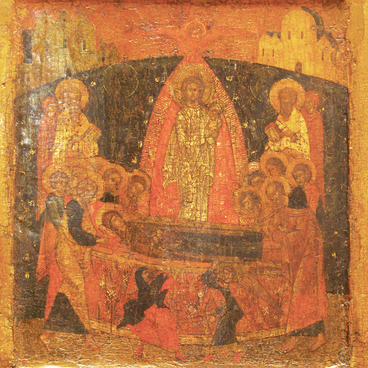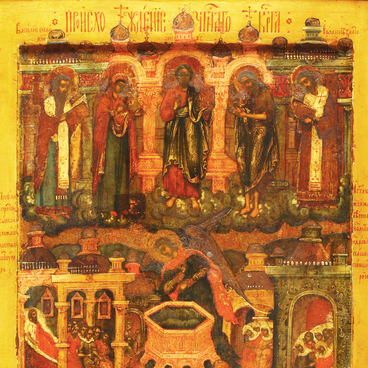The icon of Saint Philip the Deacon has been kept since 1938. It was transferred from the bottom tier of the iconostasis of the church of Saint John the Apostle, which was closed from 1938 to 1944.
Philip the Deacon painted on the icon, a member of the Synaxis of the Seventy Apostles, was born in Caesarea, Palestine where he preached Christian religion with much success. When Archdeacon Stephen was killed in Samaria, Philip the Deacon left Caesarea to replace him. Among many citizens baptized by Philip the Deacon there was notorious Simon Magus who offered apostles payment in exchange for their empowering him to impart the power of the Holy Spirit to anyone on whom he would place his hands.
Having been visited by Peter the Apostle and John the Apostle, Philip the Deacon was told by an angel of the Lord to go to the road between Jerusalem and Gaza ruined by the revolted Hebrews. There he encountered the Ethiopian eunuch, the treasurer of the Candace, Queen of the Ethiopians, who was reading the Book of Isaiah in his chariot. Philip asked the Ethiopian, ‘Do you understand what you are reading? ’ Following his request, Philip explained the text to the eunuch ‘… he is brought as a lamb to the slaughter, and as a sheep before her shearers is dumb, so he openeth not his mouth.’ Philip told him about Jesus Christ and baptized. After that, the Spirit of the Lord brought Philip to Ashdod where he continued to announce the Word of God.
Later he returned to Caesarea to his four daughters that had the gift of prophecy. One of them, Hermione, was a famous healer and cured people. According to religious texts, apostles appointed him the bishop in Tralles where he baptized many people and lived into old age. Books of the New Testament contain no more information of Saint Philip. The feast day to commemorate Saint Philip the Deacon is October 11 (October 24, new style) and January 4 (January 17, new style).
Based on the unity of sources and stylistic devices, the authorship can be established with certainty, the icon was painted either by painters of the Kremlin Armoury or by their apprentices. The icon painter created a distinctive work typical of the epoch. Careful depictions of precious cloth used for the deacon’s stikharion as well as luxuriant and magnificent liturgical vestment arouse admiration. Contrary to general opinion on some restrictions implied by tempera, the talented painter managed to convey all beauty of rich garments as a reflection of glow of the Kingdom of Heaven. Having slightly turned the figure, the painter managed to revive the posture of the deacon and his talented brushstrokes enriched the saint’s face with vitality and spirituality.
Like alive or fryazhskaya manner of icon painting is characterized by special shaping and forming of a head with numerous layers of paint. The painter of the icon was very good at these techniques and like all other apprentices of the school of the Kremlin Armoury tried to improve and enlarge icon painting skills. Those icon painters who possessed the method enabling them to achieve perfect shading were sure that their searches were correct as fryaz gave them a unique possibility to convey the psychological atmosphere of the image.
It helps to convey the most complex emotions. The face of Saint Philip can exemplified it as only at first sight his face is calm and impassive but, having taken a closer look, the face conveys solemnity, benevolence, sympathy, attention, and kindness. No doubt, these feelings help to enlarge interaction with viewers.
Philip the Deacon painted on the icon, a member of the Synaxis of the Seventy Apostles, was born in Caesarea, Palestine where he preached Christian religion with much success. When Archdeacon Stephen was killed in Samaria, Philip the Deacon left Caesarea to replace him. Among many citizens baptized by Philip the Deacon there was notorious Simon Magus who offered apostles payment in exchange for their empowering him to impart the power of the Holy Spirit to anyone on whom he would place his hands.
Having been visited by Peter the Apostle and John the Apostle, Philip the Deacon was told by an angel of the Lord to go to the road between Jerusalem and Gaza ruined by the revolted Hebrews. There he encountered the Ethiopian eunuch, the treasurer of the Candace, Queen of the Ethiopians, who was reading the Book of Isaiah in his chariot. Philip asked the Ethiopian, ‘Do you understand what you are reading? ’ Following his request, Philip explained the text to the eunuch ‘… he is brought as a lamb to the slaughter, and as a sheep before her shearers is dumb, so he openeth not his mouth.’ Philip told him about Jesus Christ and baptized. After that, the Spirit of the Lord brought Philip to Ashdod where he continued to announce the Word of God.
Later he returned to Caesarea to his four daughters that had the gift of prophecy. One of them, Hermione, was a famous healer and cured people. According to religious texts, apostles appointed him the bishop in Tralles where he baptized many people and lived into old age. Books of the New Testament contain no more information of Saint Philip. The feast day to commemorate Saint Philip the Deacon is October 11 (October 24, new style) and January 4 (January 17, new style).
Based on the unity of sources and stylistic devices, the authorship can be established with certainty, the icon was painted either by painters of the Kremlin Armoury or by their apprentices. The icon painter created a distinctive work typical of the epoch. Careful depictions of precious cloth used for the deacon’s stikharion as well as luxuriant and magnificent liturgical vestment arouse admiration. Contrary to general opinion on some restrictions implied by tempera, the talented painter managed to convey all beauty of rich garments as a reflection of glow of the Kingdom of Heaven. Having slightly turned the figure, the painter managed to revive the posture of the deacon and his talented brushstrokes enriched the saint’s face with vitality and spirituality.
Like alive or fryazhskaya manner of icon painting is characterized by special shaping and forming of a head with numerous layers of paint. The painter of the icon was very good at these techniques and like all other apprentices of the school of the Kremlin Armoury tried to improve and enlarge icon painting skills. Those icon painters who possessed the method enabling them to achieve perfect shading were sure that their searches were correct as fryaz gave them a unique possibility to convey the psychological atmosphere of the image.
It helps to convey the most complex emotions. The face of Saint Philip can exemplified it as only at first sight his face is calm and impassive but, having taken a closer look, the face conveys solemnity, benevolence, sympathy, attention, and kindness. No doubt, these feelings help to enlarge interaction with viewers.



